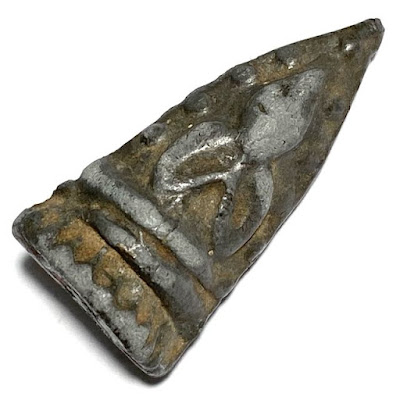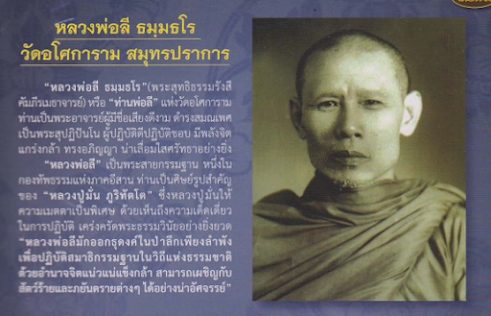Pra Put Pim Sorng Hnaa Fang Khiaw Hmaa Phal Double Sided Buddha Amulet Alchemical metals & Wolf Tooth Insert by Khmer Monk LP Dam. This 2 sided Buddha Amulet, is a rare and highly sought-after model among collectors of sacred Buddhist artifacts. This particular amulet is made from Nuea Dtakua Aathan Pasom Parort Fang Khiaw Hmaa Pha, a unique and high-quality material that is prized for its spiritual significance and durability. The amulet's design is based on a pre-existing model created by a great master, which Luang Por Dam skillfully adapted and refined to create a truly exceptional piece.
The process of creating this amulet reveals the skill and mastery in alchemical metallurgy and Wicha, of Luang Por Dam. The amulet begins as a leaden statuette, carefully forged using alchemical metallurgy to imbue it with spiritual energy. Once the statuette is complete, a piece of parchment paper is inserted into the amulet, containing a sacred magic spell written in Khom Agkhara, an ancient and powerful script used in Buddhist rituals. The spell is believed to enhance the amulet's spiritual properties and provide protection to the wearer. To further amplify the amulet's potency, a wolf's canine tooth is inserted into the statuette, a rare and precious ingredient that is said to possess powerful spiritual energy.
The result is a truly unique and powerful amulet that is said to possess a range of benefits, from spiritual growth and protection to good fortune and prosperity. The Pra Put Pim Sorng Hnaa Fang Khiaw Hmaa Phal 2 sided Buddha Amulet in Pim Lek is a true masterpiece of Buddhist art and a testament to the skill and craftsmanship of Luang Por Dam. Its rarity and spiritual significance make it a highly prized possession among collectors and those seeking to enhance their spiritual journey.
Luang Por Dam, of Wat Kuti, was an olden days Khmer Sorceror Monk who stayed at Wat Kuti in the Pre Modern Era. He is said to have been of the same Generation and approximate age of the Great Luang Phu Suk of Wat Pak Klong Makham Tao, and lived long ago. Nobody has ever been able to compile a full biography of this monk, whose Khmer past is obscured from history.
Luang Por Dam made his amulets in his own inimitable way with his own particular method, which came from his Khmer Sorcery Wicha. He was able to manipulate alchemical metals and to 'riak parort', which means 'to call alchemical mercury'.
He would make the amulets by the alchemical method of using Incantations and meditative prowess to call the mercury to flow to him and guide them into the casting molds with magical spell-casting.
Apart from being famous for Kong Grapan Chadtri Klaew Klaad and 'Gan Sadtw Pit Raay' (protect against poisonous beasts), the amulets of Luang Por Dam are known for their power to erase Black Magick. It is said that if a house is cursed, or there are any sorcerous magical spells influencing the house, to walk in with one of Luang Por Dam's amulets will dispel the curse or Black Magick Immediately, dispersing it and banishing it.
In those olden times, as Luang Por Dam would make amulets for the devotees at the temple, he became famous from many stories of miraculous lifesaving events connected with his amulets. Ranging from people being attacked by bandits and shot at at point blank range, but the guns would not fire, to surviving deadly accidents in the face of certain death.
But his amulets also then became famous outside of his locality and to spread around the provinces, because of Rice!
Luang Por Dam's temple needed rice, and Luang Por Dam would also have to go to Sara Buri township often to get rice for the temple, and would take his amulets to exchange with the market farmers for rice.
In the beginning, not many people took much notice, but he would exchange one amulet for a cart of rice with some traders. But after some time, there were some devotees who payed reverence and gave alms to Luang Por Dam, and received an amulet as a gift from him for their kindness.
The devotees took the amulet and hung it up against a tree to test it with a revolver, by shooting at it, but however they tried, the gun would not shoot when pointed at the amulet.
The amulets of Luang Por Dam of Wat Kuti are now extremely rare to encounter, and are highly renowned for their powerful Kong Grapan Chadtri, Maha Ud, Klaew Klaad and Gan Sadtw Pit Raay Powers.
His first edition came to be, because of the Thai devotees of the area hearing of Luang Por Dam being from the Khmer side of the border, and that he was a Tudong Forest Monk, so they came to ask him for a way to prevent the Black Magick spells which were being placed on them using Khmer Necromancy and Black Magick.
Luang Por Dam then made his first edition, using the wolf's teeth inserts, which are now so rare and famousl powerful, with Anti Black Magick and Kong Grapan Chadtri Maha Ud klk Protective Sorcery to keep his devotees safe and banish any evil curses they may have had afflicting them.
The wolfs teeth were obtained by Luang Por Dam, as he was wandering through the forests of the Khao Gaew Jungle, and he came upon the scene of a pile of skeletons of wolves, and a couple of tiger skeletons, all in one area.
He concluded that the wolves must have died in their struggle with the tigers, but that the wolves, despite being much smaller, were as brave and fearless and just as much a fierce hunter as the much larger tiger himself.
He took the teeth and empowered them throughout his Tudong wandering times with Maha Amnaj, Maha Ud, Klaew Klaad and Kong Grapan Chadtri Magic, for later use, in these amulets. He made the amulets in various models, including the Pra Put Buddha image, the Pra Pid Ta Pra Pim Pak Pao (single Pidta) up to the Pra Pid Ta Pim Haa Gler (5 sided Pidta), which is known in the present day as 'Pid Ta Piang Chompoo Haa Gler'.
















































.png)


.JPG)